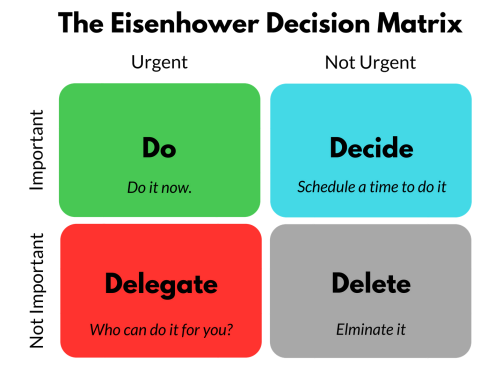What is productivity? Being Productive or Just Busy
Busy vs Productive
There's a difference between being busy and productive. Sometime we kind of mis-thinking that these two terms is the same.
- Being busy, is having task piled up and you running around frantically trying to reduce or eliminate those heavy pile one by one.
- Being productive, is doing necessary task at hand so that we can achieve our goals efficiently.
Having to chase deadline is usually what busy people do. On the other hand, productive people always have everything wrap up under a plan. They always prepare and plan ahead, every task and managed them by priority.
Cutting down the unnecessary and focusing on the essential is going to be a quick way to boost your real productivity
So, what we can do to be more productive?
Key Principles
There are four key principles related to productivity:
- Task management, organizing tasks at hand.
- Setting priority, determine the importance / urgency.
- Time management, structure your day / time so that you can get the most important things done.
- Focus, reduce distractions.
Let's get into more detail about these principles.
1. Task Management
Our brain can hold a limited number of information at one time. So, we can't always rely on our brain to store every information or tasks that we have. It's better to write it down somewhere, so that we can recall that task / information later on.
GTD or Getting Things Done which was introduced by David Allen, it starts with brainstorming and capturing ideas in a notepad or any other tool. Every time an idea pops into your head, you make a note of it. With GTD, you break down big tasks into the smallest possible next step so that your tasks are very actionable. GTD also gives you an algorithm to process your tasks and organize them into things that need to be done sooner or later.
Other tool that we can used is Kanban boards, which mostly used on project management. In Kanban boards, you write down every task at hand on a card, and then categorized it into one of these state: to-do, doing, and done. This way we can have a good picture or visualization of task progress.
2. Setting Priority
Sometime it can be very overwhelm when there's a ton of tasks need to be done, which eventually may hinder us the effort to complete even one task. That's where setting up priority kicks-in. We can use Eisenhower matrix to segregate these tasks based on importance vs urgency.

We can also use Pareto principle (80/20 rule) to setup priority, by focusing only to 20% task that really matter which going to produce results. This approach is heavily rely on experience. If you just starting out, better to stick with eisenhower matrix.
Sometime, it may happen after we apply Eisenhower matrix, we still got plenty task to do. If that's the case, then Brian Tracy’s ABCDE method might help you on that. Here’s how it works:
- Go through your list and give every task a letter from A to E (A being the highest priority)
- For every task that has an A, give it a number which dictates the order you’ll do it in
- Repeat until all tasks have letters and numbers
Rather than asking ‘What’s the most important thing I can do today?’, time multipliers ask ‘What’s the most important thing I can do today that would make tomorrow better?’ In other words, by thinking about how we use our time today, we can free up our hours in the future. ~ Rory Vaden
3. Time Management
Busy people always complain that they don't have enough time to finish their tasks. On the contrary, being productive is always being prepared. Once you figure out the essential tasks need to be done, next thing to do is to plan your day when is the right time you should focus working on a task. One approach is to estimate how much time you want to spend to working on a task, then work on this time period. When the times runs out, take a break. This approach is called time-boxing.
Other technique you can use is pomodoro technique. This technique requires you to break your workday into 25-minute blocks of time followed by a 5-minute break. After about four of these ‘pomodoros’, take a longer break. By creating a faux-urgency that you have only 25 minutes left to complete a task, you tend to work faster and more focused. The forced break reminds you to take a breather once in a while and prevents mental fatigue.
4. Focus
You can do all the planning and prioritizing in the world but if you are easily distracted and switch between tasks, then you’re not managing your time effectively. So, it’s crucial to focus on the task at hand, finish them, and move on to the next. What you can do to stay focus, is to create not to-do list. It's quite similar to usual to-do list, but instead you list out things that you shouldn't be doing and stick to it. The real challenge is sticking to it and you need an insane amount of willpower to work against your impulses. But, by listing all your productivity-hampering habits, you tell your brain that you’ll no longer focus on them.
Ideas (keep-in-mind)
- If you want to increase your productivity, think about what is driving you to do so. What is the purpose that's driving your actions? Your ultimate purpose will help steer you when you face challenges.
- Better productivity requires some work on your side. It may take up to three months to form a new habit. Once it becomes a habit, it becomes easier to integrate into a routine
